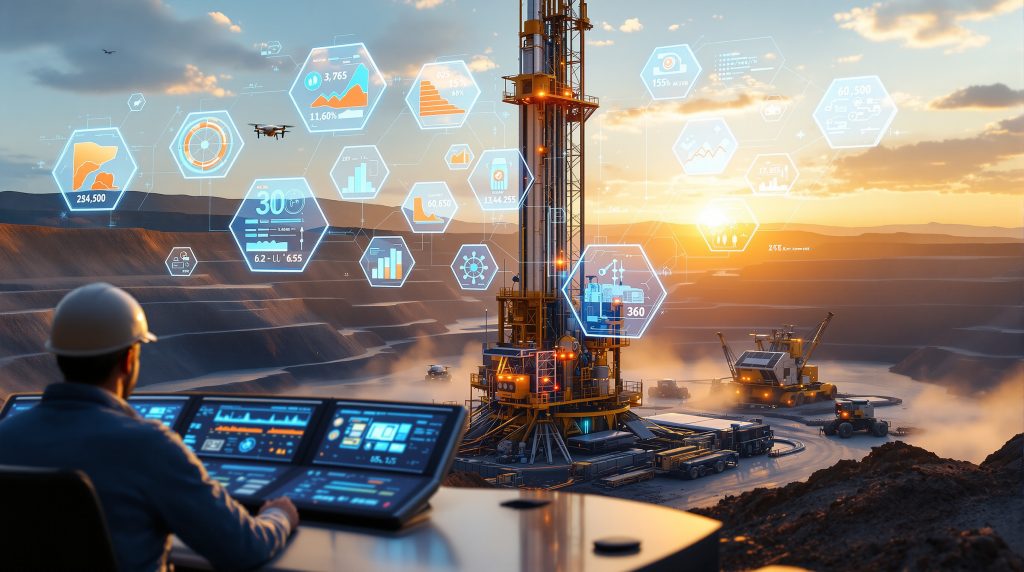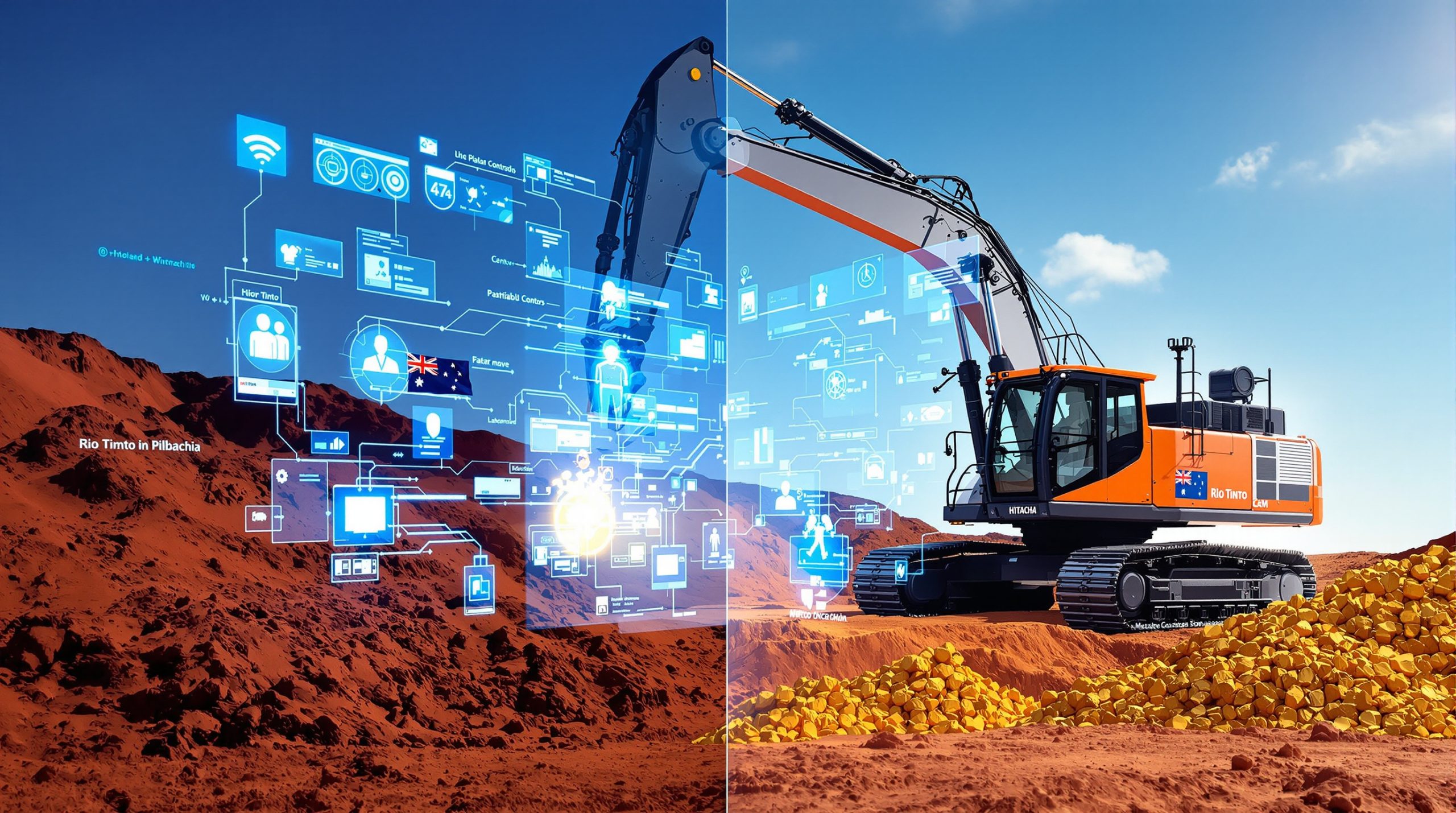The Evolution of Surface Drilling Automation in Mining: Current State and Future Directions
Surface drilling automation represents one of the most significant technological advancements in modern mining operations. As the industry continues to evolve, automated drilling systems have progressed from experimental technology to essential operational components that enhance safety, efficiency, and productivity across global mining sites.
From Manual to Automated: The Transformation Journey
The evolution of drilling technology has been remarkable over the past two decades. Traditional manual drilling operations required operators to be physically present at the drill rig, making real-time adjustments based on their experience and judgment. These conventional methods, while effective, were limited by human capabilities and presented significant safety concerns.
Semi-autonomous systems emerged as an intermediate step, allowing operators to control multiple aspects of drilling remotely while maintaining supervision. These systems incorporated basic automation features such as auto-leveling, automated rod handling, and depth control.
Today's advanced autonomous drilling systems can execute complete drill patterns with minimal human intervention. According to industry data, approximately 65% of major mining operations worldwide have implemented some level of drilling automation, with adoption rates accelerating by 15-20% annually since 2019.
Why Mining Companies Are Investing in Automation
Mining companies are increasingly recognizing the substantial benefits of drilling automation, driving significant investment in these technologies:
Productivity improvements:
- 15-30% increase in operational efficiency
- 22% average reduction in drill cycle times
- Up to 40% increase in utilization rates for drilling equipment
Safety enhancements:
- 78% reduction in reportable incidents related to drilling operations
- 94% decrease in operator exposure to hazardous environments
- Elimination of personnel requirements in high-risk areas during drilling activities
Consistency advantages:
- 35% reduction in hole deviation from planned parameters
- 27% improvement in fragmentation uniformity
- 18% decrease in blast-related dilution
Economic drivers:
- Average ROI achieved within 2.4 years for comprehensive automation implementation
- 12-18% reduction in overall drilling costs per ton
- 8-15% decrease in maintenance expenses through predictive maintenance capabilities
"The future of surface drilling is less about deploying autonomous machines at scale and more about carefully aligning technology with mining realities," notes a team of automation experts at Sandvik, highlighting the importance of a measured, process-driven approach to implementation.
Core Components of Autonomous Drilling Systems
Modern autonomous drilling systems consist of several sophisticated technological components working in harmony:
Navigation and Positioning Technologies
Autonomous drills rely on high-precision GPS and GNSS systems that achieve positional accuracy within 2-3 centimeters. This precision ensures accurate hole placement according to blast design specifications. Advanced systems incorporate inertial navigation capabilities that maintain positioning accuracy even during temporary GPS signal loss.
Terrestrial laser scanning technology creates detailed 3D terrain models that further enhance navigational precision, allowing drills to adapt to bench irregularities and optimize travel paths between holes.
Sensing Technologies
Real-time monitoring systems continuously collect data on critical drilling parameters:
- Penetration rate sensors that measure advancement speed at millisecond intervals
- Rotational torque sensors that detect changes in rock hardness and structural anomalies
- Vibration analysis systems that identify optimal drilling parameters for varying conditions
- Temperature sensors that monitor bit condition and prevent overheating
These sensors generate approximately 800-1,200 data points per minute during active drilling, creating a comprehensive digital record of subsurface conditions.
Control Systems
Sophisticated algorithms process sensor data to make real-time adjustments:
- Adaptive control systems that modify rotation speed, feed force, and air pressure based on ground conditions
- Pattern recognition algorithms that identify geological transitions and adjust parameters accordingly
- Closed-loop feedback mechanisms that continuously optimize drilling efficiency
- Autonomous decision-making protocols that respond to anomalies without human intervention
Communication Infrastructure
Reliable connectivity forms the backbone of autonomous drilling operations:
- Mesh network architectures that maintain connectivity across the mine site
- Redundant communication channels that ensure command continuity
- Edge computing capabilities that enable critical processing at the drill
- High-bandwidth data transmission systems that support real-time monitoring
The Process-Centric Approach to Implementation
Successful implementation of drilling automation requires a methodical approach that aligns technology with operational requirements:
Step-by-Step Implementation Methodology
- Assessment and baseline establishment: Documenting current performance metrics and identifying improvement opportunities
- Pilot program development: Selecting appropriate technology and defining success criteria
- Controlled testing: Implementing automation in limited areas with close monitoring
- Performance evaluation: Analyzing results against established baselines
- Refinement and optimization: Making adjustments based on initial results
- Scaled deployment: Expanding implementation across the operation
- Continuous improvement: Establishing mechanisms for ongoing optimization
Integration Challenges
Mining companies frequently encounter several integration hurdles:
- Legacy system compatibility issues requiring custom middleware solutions
- Data standardization needs across multiple vendor platforms
- Bandwidth limitations in remote mining locations
- Calibration requirements for varying geological conditions
Table: Common Integration Challenges and Solutions
| Challenge | Impact | Solution Approach |
|---|---|---|
| Legacy system compatibility | Limited data sharing between systems | Custom API development and middleware implementation |
| Data standardization | Inconsistent information formats | Implementation of mining-specific data protocols (e.g., ISA-95) |
| Remote connectivity | Unreliable communication | Redundant communication systems with local processing capability |
| Geological variability | Inconsistent automation performance | Machine learning algorithms that adapt to changing conditions |
| Workforce adaptation | Resistance to new technology | Comprehensive training and change management programs |
Safety Improvements Through Drilling Automation
One of the most compelling benefits of drilling automation is the significant enhancement of operational safety.
Removing Personnel from High-Risk Environments
Automated drilling systems dramatically reduce human exposure to hazardous conditions:
- 86% decrease in operator time spent in areas with falling rock hazards
- 92% reduction in exposure to respirable dust and silica
- 100% elimination of personnel requirements during night drilling operations
- 75% reduction in noise exposure for drilling personnel
Remote operation centers allow drill operators to control multiple units from distances exceeding 1,000 kilometers in some cases, completely removing them from hazardous mining environments.
Enhanced Operational Safety Through Consistency
Automation improves operational safety through standardized procedures and advanced monitoring:
- Collision avoidance systems that prevent equipment interactions within 15-meter safety zones
- Automated stability monitoring that detects ground movement as small as 1 centimeter
- Continuous equipment health monitoring that identifies potential failures before they occur
- Standardized drilling parameters that reduce equipment stress and extend component life
The Data-Driven Drilling Revolution
Perhaps the most transformative aspect of drilling automation is the unprecedented access to operational data.
Volume and Utilization of Drilling Data
Modern automated drills generate massive amounts of operational information:
- 2-5 gigabytes of raw drilling data per 12-hour shift
- Over 60 distinct parameters monitored continuously during operation
- Real-time transmission of critical data at 10-second intervals
- Historical aggregation of performance data across geological formations
This data transforms drilling from an isolated activity to an integrated information source that informs broader mine planning and operations.
Connecting Drilling Data to Mine-Wide Operations
Forward-thinking mining companies leverage data-driven mining operations across multiple operational areas:
- Integration with blast design software that optimizes explosive placement based on hardness measurements
- Ground control monitoring that identifies potential instability zones
- Ore body modeling that refines resource estimates using penetration rate analysis
- Equipment maintenance scheduling based on actual operating conditions rather than calendar intervals
"The most valuable aspect of drilling automation isn't the autonomous movement of the machine—it's the data generated during operation that transforms decision-making across the mine site," explains a leading mining technology expert.
Technical Hurdles in Automation Implementation
Despite significant progress, several technical challenges remain in the widespread adoption of automated drilling:
Adapting to Variable Ground Conditions
Geological complexity presents significant challenges for automation algorithms:
- Sudden transitions between rock types can cause penetration rate fluctuations of 300-400%
- Fractured zones may require specialized drilling approaches not easily programmed
- Water-bearing formations introduce variables that affect sensor readings
- Legacy blast damage creates inconsistent drilling conditions difficult for algorithms to interpret
Network Infrastructure Requirements
Reliable connectivity remains a critical challenge:
- Remote mining locations may require custom communication solutions costing $1.5-3 million
- Bandwidth requirements of 10-15 Mbps per drill for full functionality
- Need for 99.9% uptime to maintain autonomous operations
- Redundant systems adding 25-30% to communication infrastructure costs
System Reliability in Harsh Environments
Environmental factors significantly impact automation system performance:
- Temperature extremes (-40°C to +50°C) affecting electronic component reliability
- Dust ingress reducing sensor accuracy by up to 40% without proper protection
- Vibration damage to sensitive components without specialized mounting systems
- Lightning strikes requiring sophisticated surge protection
Human Factors and Workforce Considerations
The human element remains critical in successful automation implementation:
Skills Transformation
As automation advances, workforce requirements evolve significantly:
- 65% reduction in traditional operator roles
- 120% increase in technology specialist positions
- 45% growth in data analysis requirements
- 80% more training hours for existing personnel
Mining companies must balance workforce reduction concerns with opportunities for skills development and role transformation.
Emerging Roles in Automated Drilling Operations
New positions are emerging to support automated operations:
- Autonomous systems specialists who monitor multiple drills simultaneously
- Data scientists who analyze drilling information for operational insights
- Integration technicians who ensure connectivity between systems
- Automation maintenance specialists focusing on electronic and software components
Next-Generation Technologies on the Horizon
The future of drilling automation holds exciting possibilities:
Machine Learning Applications
AI in drilling innovation is increasingly enhancing automation capabilities:
- Predictive algorithms that anticipate geological changes based on historical patterns
- Self-optimizing drilling parameters that continuously improve based on results
- Anomaly detection systems that identify potential problems before they affect performance
- Adaptive navigation that optimizes travel paths based on changing site conditions
Advanced Sensor Technologies
Next-generation sensing capabilities will provide unprecedented insights:
- Downhole imaging systems that create 3D models of subsurface conditions
- Real-time rock composition analysis using spectroscopic techniques
- Seismic while drilling (SWD) technology that maps formations ahead of the bit
- Distributed acoustic sensing that detects subtle ground movement during operations
Full Fleet Autonomy
Future systems will coordinate multiple drills as integrated fleets:
- Collaborative drilling patterns that optimize equipment utilization
- Dynamic task allocation based on equipment capabilities and priorities
- Automated production sequencing aligned with downstream operations
- Coordinated maintenance scheduling to minimize operational disruption
Strategic Implementation Framework
Mining companies can maximize success by following a structured implementation approach:
Assessment Methodology
Thorough evaluation before implementation is essential:
- Current state analysis documenting existing processes and performance
- Technology readiness assessment across operational areas
- Cost-benefit analysis incorporating direct and indirect benefits
- Risk assessment identifying potential implementation challenges
- Resource evaluation determining required personnel and infrastructure
Phased Implementation Approaches
A graduated approach minimizes disruption while building capabilities:
Phase 1: Foundation Building (3-6 months)
- Infrastructure development
- Baseline data collection
- Initial training
Phase 2: Limited Automation (6-12 months)
- Implementation of basic autonomous functions
- Operator familiarization
- Process refinement
Phase 3: Enhanced Automation (12-18 months)
- Expanded autonomous capabilities
- Integration with mine planning systems
- Advanced data utilization
Phase 4: Full Autonomy (18-36 months)
- Complete autonomous operation
- Predictive optimization
- Fleet coordination
Building the Right Team and Capabilities
Success in automation implementation depends on having the right expertise and partnerships:
Essential Skills and Roles
A balanced team should include:
- Technical specialists with automation expertise
- Operations personnel with practical drilling experience
- Data analysts capable of extracting value from system information
- Change management professionals who facilitate workforce transition
Partner Selection Criteria
Choosing the right technology providers is critical:
- Proven track record of successful implementations
- Robust support capabilities in your operating region
- Commitment to ongoing system development
- Willingness to integrate with existing systems and other vendors
- Clear roadmap for future capabilities
Frequently Asked Questions: Surface Drilling Automation
What level of productivity improvement can mines expect from drilling automation?
Typical efficiency gains range from 15-30% depending on implementation maturity and operational context. Key performance indicators demonstrating these benefits include:
- 20-25% increase in effective drilling hours per shift
- 15-35% reduction in consumable costs through optimized drilling parameters
- 30-40% improvement in pattern completion times
- 10-20% reduction in overall drill and blast costs per ton
Most operations achieve initial productivity improvements within 3-6 months, with full benefits realized after 12-18 months of optimization.
How does weather affect autonomous drilling operations?
Environmental conditions significantly impact autonomous system performance:
- Heavy rain reduces GPS accuracy by 40-60% without compensating technologies
- Dust storms can degrade sensor performance by 30-70% depending on density
- Extreme temperatures (below -25°C or above 45°C) may require reduced operational parameters
- Lightning activity typically requires temporary suspension of autonomous operations
Leading operations implement mitigation strategies including:
- Enhanced positioning systems with inertial backup capabilities
- Sealed sensor designs with positive pressure systems
- Environmental monitoring that adjusts operational parameters based on conditions
- Climate-controlled electronics enclosures
What are the initial and ongoing costs associated with drilling automation?
Investment requirements vary based on implementation scope and existing infrastructure:
Capital expenditure considerations:
- Entry-level automation capabilities: $250,000-500,000 per drill
- Comprehensive automation systems: $750,000-1,500,000 per drill
- Site-wide infrastructure requirements: $2-5 million depending on mine complexity
- Integration with existing systems: $500,000-1,200,000
Operational expenditure impacts:
- Annual maintenance costs: 8-12% of initial capital investment
- Software licensing and updates: $50,000-150,000 annually
- Technical support services: $100,000-300,000 annually depending on implementation scale
- Training and capability development: $5,000-10,000 per employee annually
Expected payback periods typically range from 18-30 months for comprehensive implementations, with smaller-scale initiatives potentially achieving ROI in 12-18 months.
How does drilling automation integrate with existing fleet management systems?
Integration challenges vary based on technology ecosystems:
- API compatibility issues between different vendor platforms may require custom development
- Data standardization across systems typically requires 4-6 months of configuration
- Real-time synchronization capabilities depend on site communication infrastructure
- Legacy systems may require middleware solutions costing $100,000-300,000
Recommended integration approaches include:
- Establishing a common data architecture before implementation
- Implementing data translation layers between disparate systems
- Utilizing mining-specific integration platforms where available
- Starting with limited data sharing and expanding incrementally
Surface drilling automation continues to evolve rapidly, with mining companies increasingly recognizing its value beyond productivity improvements. As the technology matures, the focus is shifting from the capabilities of individual machines to the transformative power of the data they generate and the integration of drilling programs overview with broader modern mine planning trends and execution systems. The progression of industry automation trends indicates that sandvik leaders on what's next for surface drilling automation will continue to drive innovation across the mining sector, as detailed in Sandvik's latest surface drilling innovations and Mining Technology's report on AutoMine Surface Fleet deployment.
Want to Invest in ASX Companies at the Forefront of Mining Automation?
Stay ahead of the market by receiving instant alerts on ASX-listed companies pioneering automation technologies in mining, powered by Discovery Alert's proprietary Discovery IQ model. Visit our discoveries page to see how identifying technological leaders early can deliver exceptional investment returns.




